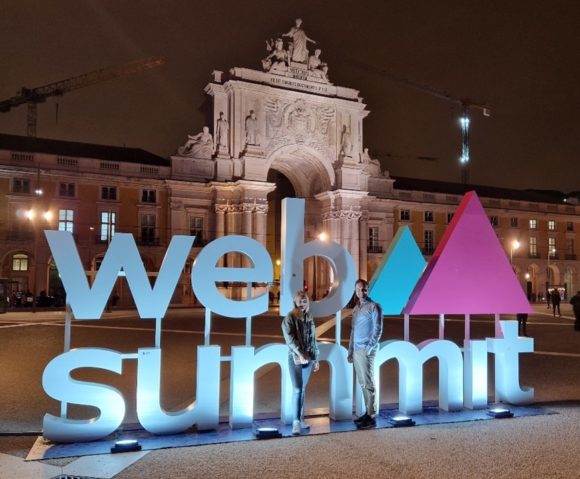As a reward for their success in CAMELOT’s company-internal innovation race in 2021, we had the chance to attend Europe’s largest start-up and tech conference, Web Summit in Lisbon. We had three days full of keynote speeches, master classes, Q&A sessions, pitches, and conversations. We summarize our experiences on trending key implications for future value chain management.

1. There is No Business Unless It’s Sustainable
Sustainability is the top priority in the current decade! No matter which session, from FinTech, trade, mobility and Web3 to “NewWork”, sustainability is an integral part for every kind of business. Especially when it comes to value chain management, there is no way around sustainability. For most companies, the largest carbon emissions are generated in the very early steps of their supply chains, from energy-intensive production of pre-products or extraction of raw materials which are often hard to quantify. Companies need to record emission data to share it with their network of suppliers and customers. Technologies like blockchain allow trusted tracking of carbon emission up to the tier-n suppliers and thus can help to make emissions more transparent and reduce it in a second step.
For more information, see also our colleague’s article “How blockchain can help to manage CO2 data across the value chain”.
2. From “Digital Twin” to “Physical Twin”
We have been talking about the necessity for digitalization for more than 20 years; for 10 years and more, we are talking about the advantages, new technologies like AI, IoT or cloud computing offer. But if you look at today’s market reality, we clearly see that most companies are still lagging behind. Digital transformation can only succeed if it is the CEO’s priority and embedded in the company’s culture. Key to successful digital transformations is openness to integrated partnerships and a strong focus on change management. People need to fully understand how AI can improve their daily business. And the change should start now because it can help to also address other priorities like sustainability or faster reaction to newly occurring crises (risk and resilience management).
We should no longer think of a physical asset, may it be production or logistics, and building a digital twin to manage the processes. Instead, the mindset needs to focus on a digital asset first, knowing that it comes with a physical representation, a physical twin.
For more information, how digital twins support carbon neutrality in logistics, see also our article “With a digital twin to carbon neutrality”.
3. From “Sick Care” to Health Care
Our health systems are tailored to the curing of patients suffering from diseases, and large pharma companies are supplying medicine to the global market. Digital innovations and the trend towards tracking body activities can turn reactive into preventive care! In the future, we will more and more apply health wearables to track and control our body values, like pulse, blood sugar, blood pressure, or sleeping quality. The data can be used to detect potentials sicknesses early-on or even proactively prevent them. The supply chain operating model for health wearables with shorter life cycles and higher cost pressure is entirely different to the traditional healthcare sector. Rather than regulatory requirements, data protection requirements will be of significance. It will be exciting to see how today’s healthcare players will react to this trend.
For more information on the challenges, pharma companies face in new business models, see this article from our colleagues at Hypertrust Patient Data (in German only).
4. Omnichannel as Imperative
E-commerce is rapidly increasing and will not stop. Especially for companies providing high volume products like furniture or sports equipment, this trend is a challenge. To survive in the highly competitive market, they need to react to the customers’ preferences of shorter lead times and increasing customer experience. Providers need to change from large and far-out mega stores to smaller pop-up stores close to the city centers. Limited warehouse capacity claims for differentiated distribution channels – store pickups combined with home deliveries. But traditional retail supply chains in these sectors are not yet designed to optimally support omnichannel approaches. Different channels require different approaches for demand planning and inventory management.
In the pop-up stores, a technology like augmented reality can be used to give the customer the best idea of how a purchase might look on himself or in their own flat. Besides the increased customer satisfaction, this trend can help to reduce cost-intensive returns. And it is just a question of time when these companies start to introduce lifecycle-prolonging concepts like re-usage of items to answer to the demand for sustainability, though further increasing supply chain complexity.
For more information on how to design omnichannel supply chains applied to the full-assortment grocery retail industry refer to the following article on future supply chains in grocery retail.
5. Technology Is Changing Logistics
New technology is drastically changing logistics. The current truck driver shortage will continue to increase in the upcoming years. One answer discussed in Lisbon could be autonomous driving – which might become a real game changer for road and rail transportation of goods. Constraints like imposed breaks for long distances, sickness of drivers and overnight stays away from home would no longer exist. With road transport becoming faster, more reliable, and cheaper, it will be able to compete stronger with other transport modes like rail transport.
Another imminent trend is the change from big warehouses outside the cities to smaller ones closer to the customers. This can be enabled by shelf-climbing 3D warehouse robots, to make better use of limited available space and allow for vertical warehouse extension. This responds to decreasing customer tolerance times in last mile delivery.
For more information, see this article on trends on digital warehousing.
These are just five of the key trends, we discussed while at Web Summit in Lisbon. Which one is your favorite? And what do you miss? Reach out to us on LinkedIn, we look forward to the discussion!
We would like to thank Florian Kreitz for his valuable contribution to this article.

